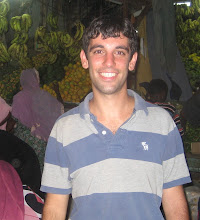Colorful, dirty, chaotic, friendly—finding accurate adjectives for my first impressions of Guatemala City is difficult. Almost 2.5 million people call the largest city in Central America home, living about 5,000 meters above sea level. My Rough Guide minced no words in describing the place as “grim…a depressing vision of urban blight.” I would beg to differ. Perhaps “beautiful” would not be an accurate descriptor, but the city has a certain charm. In a sense, I was reminded a lot of Saigon—a city of contrasts. I wandered from the National Palace and Plaza Mayor at the center of the Old City to urban shopping malls and gleaming office buildings in the modern Zona 4. The New City was glossy and tall, filled with skyscrapers, shopping malls, and every American chain imaginable. The Old City retained more of a traditional air, with narrower, packed streets. In general, the buildings themselves were nothing to write home about—mostly crumbling concrete edifices—but the streets were crowded with vendors and the wide open storefronts displayed everything from paint to pharmaceuticals. In between, comedores served up filling lunch plates from steaming pots and street vendors fried tortillas hawked fresh fruits. Street urchins, professionally-dressed businessmen, and Mayan women in traditional dresses all contributed to the colorful mélange.
My first night was spent comfortably recovering from a ridiculous week of finals and moving out at Duke in a pleasant hotel right in the heart of Zona 1, but after an entire twenty-four hours passed without hearing a word of English, I decided that prior to any further research, I should get myself to a Spanish school for a much-needed refresher. The town of Quezaltenango (commonly known by its Mayan name, Xela), perched in the Western Highlands, offers an ideal mountainous backdrop with the added advantage of headquartering many of the country’s Fair Trade Cooperatives. I purchased a first-class bus ticket (think old Greyhound, as opposed to the second class “chicken busses,” which are old American school busses) for a five hour ride heading from the already elevated capital up impossibly steep climbs—upwards almost the entire time, with our bus’s transmission threatening to give out for most of the trip (in fact, the trip was only slated to last four hours, but a combination of rickety engine parts, random mountainous traffic jams, and construction for miles and miles seemingly following the American logic of ripping up an entire road and then proceeding to work excruciatingly on single small stretches extended the journey).
The panoramic images from the bus window brought back memories of Africa, with small huts of all sorts of make-shift materials crammed into hillsides. Small towns with crammed main streets straddled the highway, featuring ubiquitous broken-down cement-block cookie-cutter buildings featuring brightly painted advertisement facades. One of the themes in the bit of literature I’ve read so far is the huge discrepancies in Guatemala between the “haves” and “have-nots.” Depending on the author or context, dividing lines are rural versus urban, indigenous versus Hispanic, or based upon various geographic divides. Certainly discrimination an inequity has been a recurring struggle and primary motivator in the 36-year civil war.
Wherever one is, there are those classic travel moments that make the journey memorable. Last night at my Xela hostel was just such a moment; I claimed a bunk in a grungy cement grotto and then headed up to the kitchen to check out the other inhabitants. Like something out of a movie, the cast included two Australian Communists decked out in full Rastafarian gear, a pretty Dutch girl working on a tourism internship, and an American ex-Coast Guard Officer as night manager. They were cooking dinner and invited me to join, and we sat around all night drinking tea, joking, and sharing travel stories. A great introduction (and a chance to revert to some English!)
The town is the center of this highlands department (similar to state), and though a former capital of the country, it seems rather modest and unassuming with its narrow, winding cobble-stoned streets—altogether an excellent place to ensconce myself and begin an intensive week of language review. The plan is five days of classes and a week homestay with a Guatemalan family, hopefully allowing opportunities to study and make some connections for research.
Friday, May 11, 2007
Subscribe to:
Post Comments (Atom)

No comments:
Post a Comment